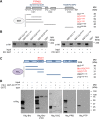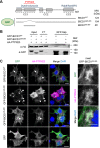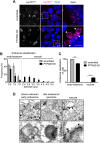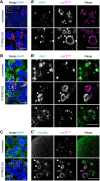PTPN23 binds the dynein adaptor BICD1 and is required for endocytic sorting of neurotrophin receptors
- PMID: 32079660
- PMCID: PMC7132798
- DOI: 10.1242/jcs.242412
PTPN23 binds the dynein adaptor BICD1 and is required for endocytic sorting of neurotrophin receptors
Abstract
Signalling by target-derived neurotrophins is essential for the correct development of the nervous system and its maintenance throughout life. Several aspects concerning the lifecycle of neurotrophins and their receptors have been characterised over the years, including the formation, endocytosis and trafficking of signalling-competent ligand-receptor complexes. However, the molecular mechanisms directing the sorting of activated neurotrophin receptors are still elusive. Previously, our laboratory identified Bicaudal-D1 (BICD1), a dynein motor adaptor, as a key factor for lysosomal degradation of brain-derived neurotrophic factor (BDNF)-activated TrkB (also known as NTRK2) and p75NTR (also known as NGFR) in motor neurons. Here, using a proteomics approach, we identified protein tyrosine phosphatase, non-receptor type 23 (PTPN23), a member of the endosomal sorting complexes required for transport (ESCRT) machinery, in the BICD1 interactome. Molecular mapping revealed that PTPN23 is not a canonical BICD1 cargo; instead, PTPN23 binds the N-terminus of BICD1, which is also essential for the recruitment of cytoplasmic dynein. In line with the BICD1-knockdown phenotype, loss of PTPN23 leads to increased accumulation of BDNF-activated p75NTR and TrkB in swollen vacuole-like compartments, suggesting that neuronal PTPN23 is a novel regulator of the endocytic sorting of neurotrophin receptors.
Keywords: Intracellular sorting; Motor neuron; Trafficking; TrkB; p75NTR.
© 2020. Published by The Company of Biologists Ltd.
Conflict of interest statement
Competing interestsThe authors declare no competing or financial interests.
Figures







Similar articles
-
Bicaudal-D1 regulates the intracellular sorting and signalling of neurotrophin receptors.EMBO J. 2014 Jul 17;33(14):1582-98. doi: 10.15252/embj.201387579. Epub 2014 Jun 11. EMBO J. 2014. PMID: 24920579 Free PMC article.
-
Fine-tuning roles of endogenous brain-derived neurotrophic factor, TrkB and sortilin in colorectal cancer cell survival.PLoS One. 2011;6(9):e25097. doi: 10.1371/journal.pone.0025097. Epub 2011 Sep 26. PLoS One. 2011. PMID: 21966426 Free PMC article.
-
Differential effects of BDNF and neurotrophin 4 (NT4) on endocytic sorting of TrkB receptors.J Neurochem. 2016 Aug;138(3):397-406. doi: 10.1111/jnc.13676. Epub 2016 Jun 18. J Neurochem. 2016. PMID: 27216821 Free PMC article.
-
Brain-derived neurotrophic factor (BDNF) expression and function in the mammalian reproductive Tract.Hum Reprod Update. 2020 Jun 18;26(4):545-564. doi: 10.1093/humupd/dmaa008. Hum Reprod Update. 2020. PMID: 32378708
-
Circadian control of p75 neurotrophin receptor leads to alternate activation of Nrf2 and c-Rel to reset energy metabolism in astrocytes via brain-derived neurotrophic factor.Free Radic Biol Med. 2018 May 1;119:34-44. doi: 10.1016/j.freeradbiomed.2018.01.026. Epub 2018 Jan 31. Free Radic Biol Med. 2018. PMID: 29374533 Review.
Cited by
-
The node of Ranvier influences the in vivo axonal transport of mitochondria and signaling endosomes.iScience. 2024 Oct 11;27(11):111158. doi: 10.1016/j.isci.2024.111158. eCollection 2024 Nov 15. iScience. 2024. PMID: 39524336 Free PMC article.
-
The ESCRT-0 subcomplex component Hrs/Hgs is a master regulator of myogenesis via modulation of signaling and degradation pathways.BMC Biol. 2021 Jul 30;19(1):153. doi: 10.1186/s12915-021-01091-4. BMC Biol. 2021. PMID: 34330273 Free PMC article.
-
Biallelic Loss-of-Function Variants in BICD1 Are Associated with Peripheral Neuropathy and Hearing Loss.Int J Mol Sci. 2023 May 17;24(10):8897. doi: 10.3390/ijms24108897. Int J Mol Sci. 2023. PMID: 37240244 Free PMC article.
-
Selective motor activation in organelle transport along axons.Nat Rev Mol Cell Biol. 2022 Nov;23(11):699-714. doi: 10.1038/s41580-022-00491-w. Epub 2022 May 30. Nat Rev Mol Cell Biol. 2022. PMID: 35637414 Review.
-
Disruption of axonal transport in neurodegeneration.J Clin Invest. 2023 Jun 1;133(11):e168554. doi: 10.1172/JCI168554. J Clin Invest. 2023. PMID: 37259916 Free PMC article. Review.
References
-
- Alazami A. M., Patel N., Shamseldin H. E., Anazi S., Al-Dosari M. S., Alzahrani F., Hijazi H., Alshammari M., Aldahmesh M. A., Salih M. A. et al. (2015). Accelerating novel candidate gene discovery in neurogenetic disorders via whole-exome sequencing of prescreened multiplex consanguineous families. Cell Rep. 10, 148-161. 10.1016/j.celrep.2014.12.015 - DOI - PubMed
Publication types
MeSH terms
Substances
Grants and funding
- SCHIAVO/OCT15/880-792/MNDA_/Motor Neurone Disease Association/United Kingdom
- 515092 /BB_/Biotechnology and Biological Sciences Research Council/United Kingdom
- 107116/Z/15/Z /WT_/Wellcome Trust/United Kingdom
- 533334 /BB_/Biotechnology and Biological Sciences Research Council/United Kingdom
- WT_/Wellcome Trust/United Kingdom
LinkOut - more resources
Full Text Sources
Other Literature Sources
Molecular Biology Databases
Research Materials

